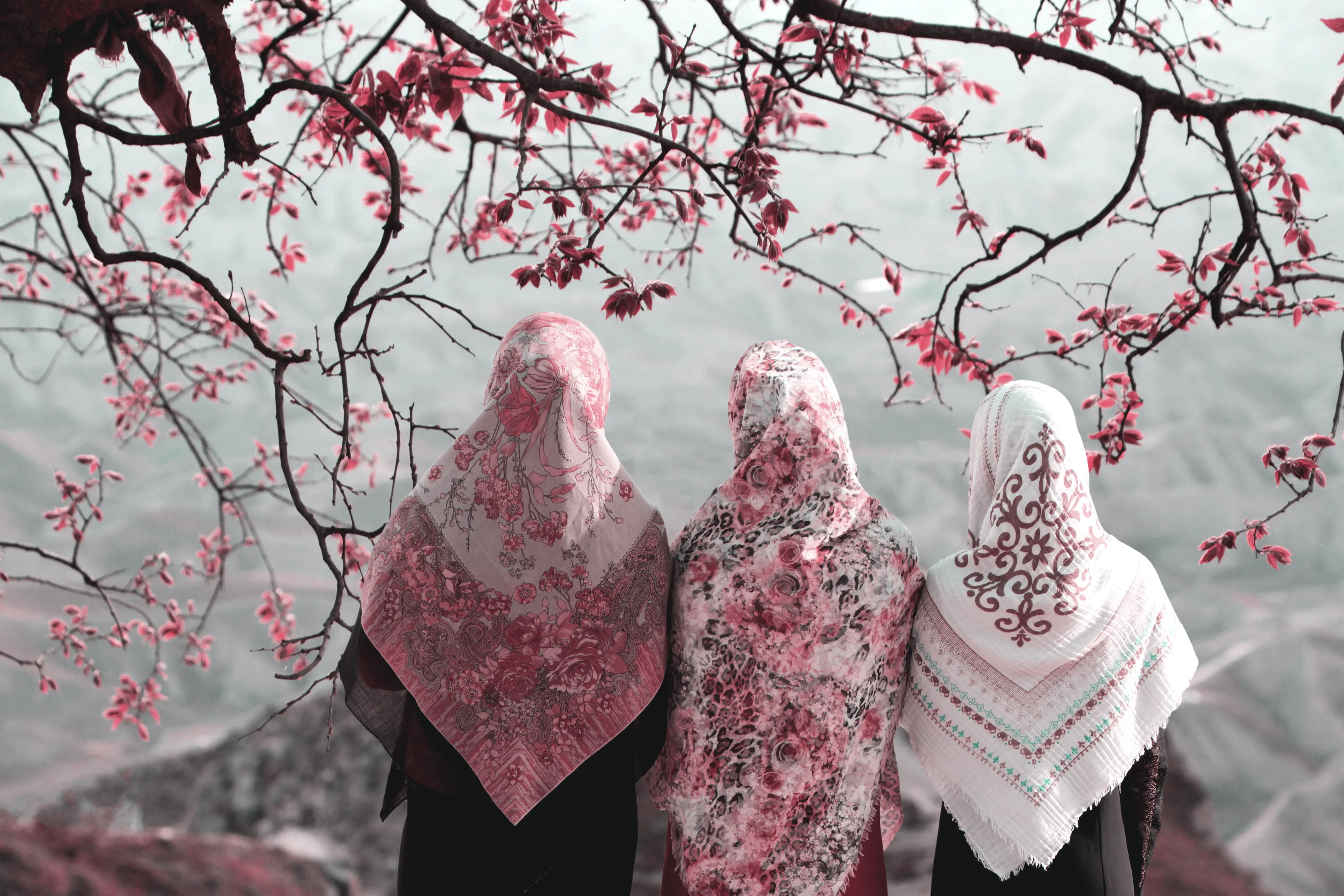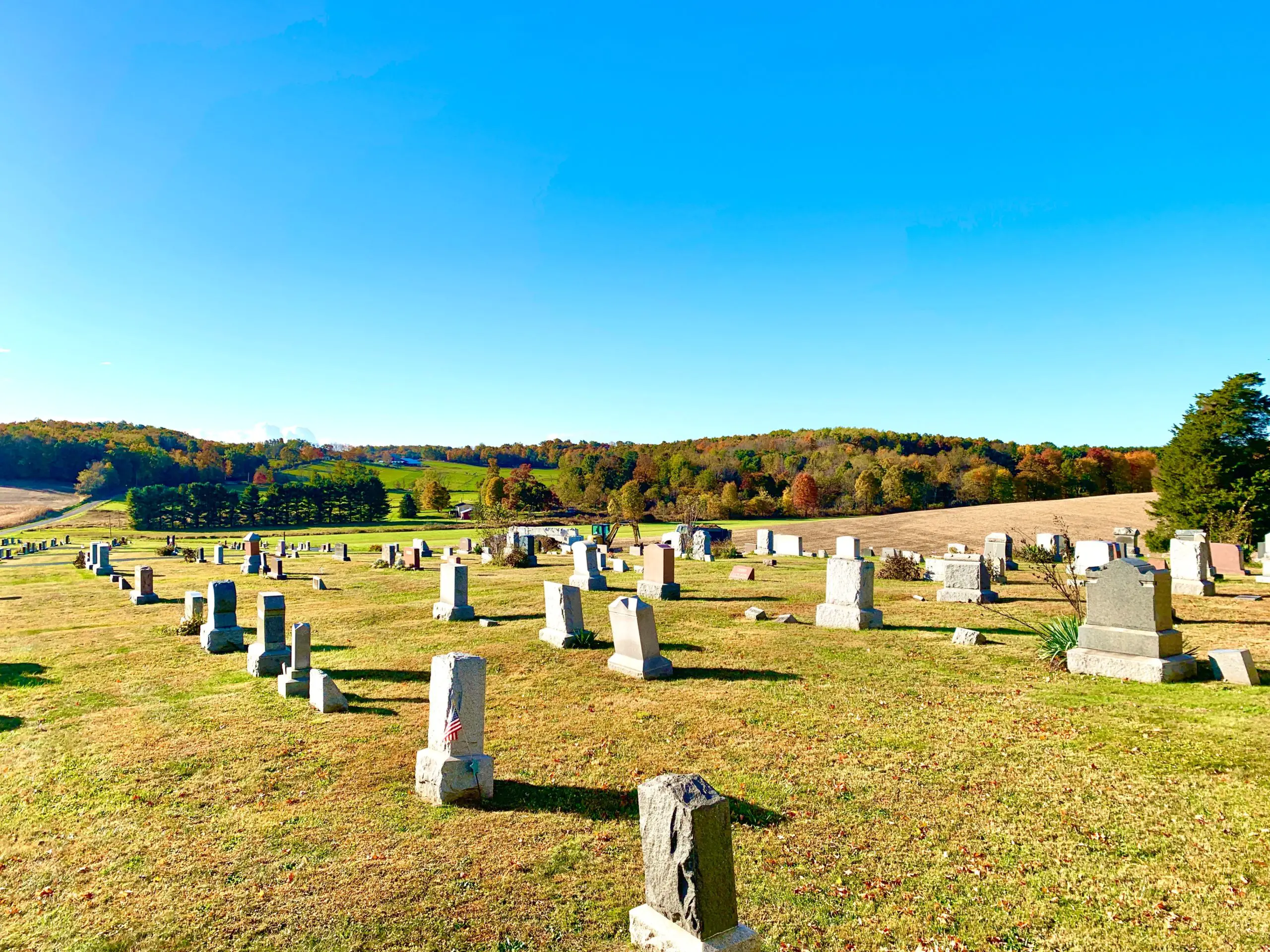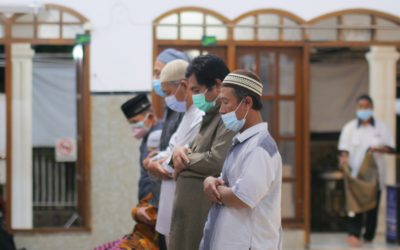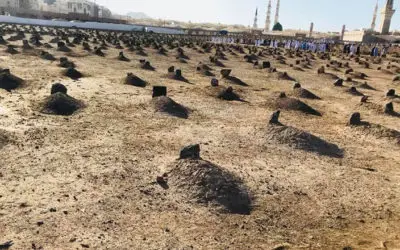The burial of the deceased is a ritual that is common across religions, cultures, and faith-traditions. Burying the deceased is a practice from among the earliest of human traditions. In fact, Muslims believe that the concept of burying traces its roots to the beginning of creation when God illustrated the process of burying one’s deceased to the children of the Prophet Adam (upon whom be peace). The Quran depicts a scene wherein a bird digs a grave in front of Qabil, one of the sons of Adam (as), as a means of demonstrating the process to him.1 Since then, Muslims believe that humans have perpetually carried on this tradition as a means of honoring their deceased and providing them their last rites.2
The burial is a sacred ritual in Islam. Attending such rituals connects one to an established age-old tradition. Burials also provide an opportunity for grieving family and friends to come together and participate in a collective sacred ritual which may help in providing some comfort and closure for the bereaved. It is for these reasons, the Prophet Muhammad (S) encouraged believers to attend and participate in the Salat al-Janazah (the funeral prayer) and to follow the funeral procession until the burial takes place, thereby attaining unto “two mountains-worth” of divine reward.3
There is a general prophetic encouragement of attending burials and visiting graveyards, and the default of commandments, encouragements, and prohibitions in Islam, is that they are generally inclusive of both genders, male and female4. However there are a number of prophetic narrations (hadiths) that point towards some special considerations given to female attendance of burials and visitation of graveyards. The interpretation and understanding of such narrations throughout Islamic history have led to certain attitudes in some Muslim cultures towards female attendance and participation in such rituals. This brief post aims to address some of the issues surrounding female visitation of burials and graveyards in light of the classical understanding of some of these narrations.
The Historical Prohibition
Perhaps the most authentic narration specifically addressing the issue of female visitation of burials is narrated by the famous female companion, Umm ‘Atiyyah.5 She reports that “we [womenfolk] were forbidden from following the Janazah (funeral procession to the graveyard), however it was not strictly enforced upon us.”6
There are a few things to consider when addressing this narration. Perhaps the most important of them is the final phrase of the narration: “…it was not strictly enforced upon us”
(ﻋﻠﯿﻨﺎ ﯾﻌﺰم ﻟﻢ و). The classical scholars of Islamic law (fuqaha) have offered a number of opinions in
regards to the meaning of this phrase, three of the major positions are as follows: (1) while this narration does seemingly prohibit females from visiting graves the prohibition was not practically emphasized like other prohibited matters within the religion, (2) this phrase illustrates that females visiting graves was not necessarily haram (prohibited) rather it was simply makruh (disliked)7, (3) the visitation of graves was not as emphasized for the women of the community as it was heavily emphasized for the men,8 with Imam al-Suyuti (d. 911 AH) saying it simply means “it’s not mandatory [upon them]”.9 The majority of Islamic scholars including Imam al-Qurtubi (d. 671 AH) adopted the second opinion (i.e. that visitation was makruh (disliked) and not haram (forbidden) while Imam Malik b. Anas (d. 179 AH) and the scholars of Madinah were of the opinion that it is in fact completely allowed without any dislike.10
Table 1.1 – The Interpretations of “…it was not strictly enforced upon us” (ﻋﻠﯿﻨﺎ ﯾﻌﺰم ﻟﻢ و)
| Opinion | Interpretation | Scholars |
| 1 (Haram – forbidden) | Female visitation of graves is prohibited however not practically emphasized / enforced like other prohibitions | Selected Scholars (classical and contemporary) |
| 2 (Makruh – disliked) | Female visitation of graves was not haram (prohibited), rather it is makruh (disliked) | Majority Opinion (including al-Imam al-Qurtubi (d. 671 AH), and others) |
| 3 (Ja’iz – allowed) | Visitation of graves is allowed for both genders, however not as emphasized for women as it is for the men of the community | al-Imam Malik b. Anas (d. 179 AH) and the Scholars of Madinah |
The two phrases found in the hadith “we were forbidden from following the janazah” and the “it was not strictly enforced upon us” are equally important and should not be separated from one another. In fact, the latter phrase is instrumental in understanding the import and context of the hadith. It should not be disregarded as simply Umm ‘Atiyyah’s perception rather her statement (“…and it was not strictly enforced upon us”) was the lived reality of the sahabiyat (female companions). This phrase also becomes the basis for many of the classical opinions surrounding this issue11 (see Table 1.1).
The Timeline: Relaxation Over Time
While examining the Prophetic Biography, one clearly sees that many commands and prohibitions were the result of gradual revelation that occurred in discrete and distinct stages (e.g. ablution, prayer, alcohol, etc.). Visitation of the graves is yet another example. Buraydah b. al-Hasib al-Aslami narrates that the Prophet (s) said: “I had previously forbidden you to visit graves, but now you may visit them”12 with another narration adding: “…for it will remind you of the hereafter.”13 We learn from this narration that the concept of visiting graves went through a process of early prohibition and subsequent allowance.
Many of the narrations of the Hadith regarding women visiting graves use the plural past tense in the passive and active voice (اﻟﺠﻨﺎﺋﺰ إﺗﺒﺎع ﻋﻦ ﻧﻬﯿﻨﺎ). This lends the possibility of the prohibition being temporal in nature. In other words, it is possible that the Prophet (s) discouraged women from attending burials in the beginning of revelation and once the rituals of the religion became more solidified in people’s hearts and minds, and the community became more accustomed to Islamically appropriate practices, he subsequently lifted the prohibition.
This idea is further substantiated when one studies some of the supporting narrations in this regard. Umm ‘Atiyyah narrates that “when the Prophet (s) entered Madinah, all of the women were gathered in a house, ‘Omar b. al-Khattab (may Allah be well pleased with him) was sent to us and he said: “I am the messenger of the Messenger of Allah to all of you, he sent me to you all so that you may pledge to not worship any deity except Allah…and we were ordered to attend Salat al-’Id and we were forbidden to attend the funerals (jana’iz).”14 On the other hand, Abu Hurayrah (may Allah be well pleased with him) narrates that: “the Prophet (s) was attending a funeral [janazah] and ‘Omar b. al-Khattab (r), upon seeing a woman in attendance, began calling out to her. The Prophet (s) responded: “leave her, O ‘Omar, for the eye weeps, the heart aches, and the bereavement is recent.”15 The first narration occured when the Prophet (s) first entered Madinah and the Prophet (s) sent ‘Omar b. al-Khattab (r) to inform the women of the basics of the religion and instructed them that they should not attend burials. The second narration seemingly depicts ‘Omar (r) attempting to act upon the prophetic prohibition stated earlier however the Prophet (s) himself interjects and orders him to leave the woman be.
A Specific Prohibition: A Closer Look
Naturally, one would be curious as to why the Prophet Muhammad (s) would prohibit anyone from attending burials and visiting graveyards to begin with. The answer is found when examining some additional relevant hadiths. Abu Hurayrah (r) narrates: “the Prophet (s) cursed the women who frequently attend the graves.”16 ‘Abdullah b. al-’Abbas (ra) also narrates a similar hadith with the following wording: “the Prophet (s) cursed the women who frequently visit the grave, those who use them as masjids
[places of worship] and place torches on them.”17 The additional words of the second narration provide an important key in the understanding of the hadith. During pre-Islamic Arabia, there were a number of inappropriate customs surrounding funerals and burials.18 The hadith mentions “taking graves as places of worship” and “placing lights (wax candles) upon graves.”19 The addition of these qualifiers lends to two possible interpretations of the hadith: (1) the Prophet (s) was speaking about the early days of revelation when visiting graveyards was forbidden, or (2) the Prophet (s) is specifically criticizing the pre-Islamic ignorant practices mentioned in the hadith (i.e. lighting candles, etc.) and not simply those who visit graves in general.20
The above explanation has been adopted by a number of classical scholars as it seems to provide a holistic understanding of all the previous narrations. The Prophet (s) originally discouraged everyone from visiting graves due to the predominance of un-Islamic and superstitious practices associated with it. However as more revelation came down, and Islamic law became more established, this prohibition was relaxed, however the Prophet (s) continued to censure some of the prevalent ignorant practices of the women (See Figure 1.1).
When we revisit the hadith of Abu Hurayrah (r) wherein the Prophet (s) instructs: “leave her, O ‘Omar…” it reveals that the Prophet (s) was acutely aware and incredibly sensitive to bereavement and grief. The hadith itself states: “…for the eye weeps, the heart aches, and the bereavement is recent.” The Prophet (s) correctly recognizes that this woman is mourning and she is attending the burial to simply pay her respects. She is not wailing or participating in
pre-Islamic ignorant practices. In fact one of the commentaries posits that not only does this hadith demonstrate that the Prophet (s) allowed this woman to attend but also that it was precisely because she was simply crying and not engaging in pre-Islamic ignorant practices, that the Prophet (s) allowed her to remain.21 A deeper look reveals many more meaningful interactions that the Prophet (s) had with women visiting the graveyard. A few notable examples are discussed below.
Figure 1.1 – Visitation of Graves in Prophetic History
The Case Study of ‘Aisha (ra)
The practical example of female companions visiting graves during the lifetime of the Prophet (s) is perhaps the strongest evidence. There are many significant examples. Anas b. Malik (r) narrates that the Prophet (s) passed by a woman sitting by a grave and weeping. He said to her: “fear Allah and have patience.”22 At that moment, the Prophet (s) offered her advice related to patience but as many classical and contemporary commentators point out “…he did not rebuke her for visiting the grave.”23 Members of the prophetic household would also frequent the graveyards themselves. ‘Aisha (ra), the wife of the Prophet (s), narrates that she asked the Prophet (s): “what shall I say, O Messenger of Allah, when I visit the graves?” The Prophet (s) responded to her by teaching her the dua’ (supplication) that is made upon entering the graveyard.24 Similarly, Fatimah (ra), the daughter of the Prophet (s), “would visit the grave of her martyred uncle, Hamza (r), every Friday, and she would pray [for him] and begin to cry.”25
The most well-known story of women visiting graveyards is the authentic narration of ‘Aisha (ra) visiting the grave of her brother, ‘Abdur Rahman (r) while returning from her trip to Makkah for Hajj. ‘Abdullah b. Abi Mulaykah reports that ‘Aisha (ra) returned one day from the graveyard. I said, “O mother of the believers, from where have you returned?” ‘Aisha (ra) said, “From the grave of my brother, Abdur Rahman ibn Abi Bakr.” I said, “Did not the Messenger of Allah (s) prohibit women from visiting graves?” ‘Aisha said, “Yes, he prohibited us at first, but then he commanded us to visit them.”26
The Positions of the Schools of Islamic Law
After careful consideration of the evidence presented in the various narrations and their respective commentaries, the scholars of Islamic law (fuqaha) have arrived at differing conclusions on the issue of female attendance of burials and visitation of graves. Of course, there will always be a small subset of scholars who deem it categorically prohibited to attend burials and visit graveyards27, among them include: Ibrahim al-Nakha’i (d. 96 AH), Ibn Sirin (d. 110 AH), Ibn Abi Shaybah (d. 235 AH), and al-Sha’bi (d. 103 AH), with the latter even stating: “had the Prophet (s) not prohibited visiting graveyards, I would have visited the grave of my own daughter!”28 However, many scholars concluded that it is allowed for women to visit the graveyards. These include opinions within the four schools of thought (i.e. Hanafi29, Maliki30,
Shafi’i31, and Hanbali32) as well as Imam Ibn Hazm (d. 456 AH) of the literalist Zahiri school.33 There are also a number of scholars in the Hanafi, Shafi’i, and Hanbali madhabs that considered it to be makruh (disliked)34 and this seems to be the predominant opinion in all three schools, with the latter three categorizing it as simply makruh (disliked) and the Hanafi school ruling that it is makruh tahrimi (prohibitively disliked). The Maliki school is perhaps the most lenient in their complete allowance of women attendance.
Conclusion
There is a vast spectrum of opinions among the classical scholars as it pertains to women attending burials and visiting graveyards. The culture surrounding female attendance and participation in such rituals reflects the diversity and variety of these opinions. Historically, the Hanafi view (i.e. that it is makruh tahrimi – prohibitively disliked) was adopted throughout the Indian subcontinent. When one observes funerals there, one easily notices that they take place with little to no female involvement. The same can be said about funerals in the Arabian Gulf.
However the culture surrounding female attendance and participation in funerals, processions, and burials, predominantly found throughout the rest of the Middle East, Africa, and many other Muslim-majority societies is vastly different.
Equally as diverse are the processes of bereavement and grief. Each person grieves in a different way. It is important to respect the wishes of the bereaved. Some may choose to attend and actively participate in these sacrosanct rituals as it gives them comfort, solace, and closure. Others may not feel comfortable attending something that they never saw the women of their family or community participating in. It is incredibly important that we recognize that our religion provides us the scope to respect, encourage, and accept either choice.
- The Holy Qur’an, Ch. 5, V. 31
- Ibn Kathir (d. 774 AH), Al-Bidayah wa Al-Nihayah, Vol. 1, P. 220
- Al-Bukhari (d. 256 AH), Al-Jami’ Al-Sahih, 1325; Muslim (d. 261 AH), Sahih Muslim, 945 (Abu Hurayrah (r) narrates that the Prophet (s) said: “whosoever attends the funeral of a Muslim hoping for the reward from Allah and remains with it until the prayer is offered over it and the burial is completed, he will return with a reward of two Qirat; each Qirat is equivalent to Mount Uhud…”)
- Al-Shinqiti, Muhammad al-Amin (d. 1394 AH), Adwa al-Bayan, Vol. 6, P. 637
- Nusaybah bint Ka’b according to Al-Qari, al-Mulla ‘Ali (d. 1014 AH), al-Ikmal fi Asma al-Rijal, p. 84-85
- Al-Bukhari (d. 256 AH), Al-Jami’ Al-Sahih, 1278; Muslim (d. 261 AH), Sahih Muslim, 938; Abu Dawud (d. 202 AH), Sunan Abi Dawud, 3167; Ibn Majah (d. 273 AH), Sunan Ibn Majah, 1577; Ahmad b. Hanbal (d. 241 AH), Al-Musnad, 6/408
- Al-Qastallani (d. 923 AH), Irshad al-Sari Sharh Sahih al-Bukhari, Vol. 2, P. 396
- Ibn Hajr al-’Asqalani (d. 852 AH), Fath al-Bari Sharh Sahih al-Bukhari, Vol. 3, P. 144-145
- Al-Sindi, Abu al-Hassan (d. 1176 AH), Hashiyat al-Sindi ‘ala Ibn Majah, Vol. 1, P. 478
- Al-’Uthmani, Shabbir Ahmad (d. 1949 CE), Fath al-Mulhim Sharh Sahih Muslim, Vol. 2, P. 458-459
- Al-’Itr, Nur al-Din (d. 2020 CE), I’lam al-Anam Sharh Bulugh al-Maram min Adillat Ahkam, Vol. 2, P. 235
- Muslim (d. 261 AH), Sahih Muslim, 977
- Tirmidhi, Abu ‘Isa (d. 279 AH), Jami’ al-Tirmidhi, 1054
- Al-Tabarani (d. 360 AH), al-Mu’jam al-Kabir, Vol. 25, P. 45, Hadith 85
- Ibn Majah (d. 273 AH), Sunan Ibn Majah, 155; Al-Nasai (d. 303 AH), Sunan al-Nasai, 1859; Ibn Abi Shaybah (d. 235 AH), Musannaf Ibn Abi Shaybah, 11295
- Tirmidhi, Abu ‘Isa (d. 279 AH), Jami’ al-Tirmidhi, 1056; Ibn Hibban (354 AH), Sahih Ibn Hibban, 3178
- Abu Dawud (d. 202 AH), Sunan Abi Dawud, 3236; Al-Nasai (d. 303 AH), al-Sunan al-Sughra, 2043; Tirmidhi, Abu ‘Isa (d. 279 AH), Jami’ al-Tirmidhi, 320;
- Al-Munawi, Muhammad ‘Abd al-Ra’uf (d. 1031 AH), Al-Taysir bi Sharh al-Jami’ al-Saghir, Vol. 2, P. 45
- Ibn Raslan (d. 844 AH), Sharh Sunan Abi Dawud, Vol. 13, P. 553
- Al-Tahawi, Abu Ja’far (d. 321 AH), Sharh Mushkil al-Athar, Vol. 12, P. 179
- Al-Sindi, Muhammad (d. 1138 AH), Kifayat al-Hajah fi Sharh Sunan Ibn Majah, Vol. 1, P. 481
- Al-Bukhari, Muhammad b. Isma’il (d. 256 AH), al-Jami’ al-Sahih, 1252
- Ibn Hajr al-’Asqalani (d. 852 AH), Fath al-Bari Sharh Sahih al-Bukhari, Vol. 3, P. 148; Al-’Uthmani, Shabbir Ahmad (d. 1949 CE), Fath al-Mulhim Sharh Sahih Muslim, Vol. 2, P. 508
- Muslim (d. 261 AH), Sahih Muslim, 974b
- Al-Hakim Al-Naysaburi (d. 405 AH), al-Mustadrak ‘ala al-Sahihayn, Vol. 3, P. 30, 4319
- Al-Bayhaqi, Abu Bakr (d. 458 AH), Al-Sunan Al-Kubra, 6659
- Al-Basam, ‘Abdullah (d. 1423 AH), Tawdih al-Ahkam min Bulugh al-Maram, Vol. 3, P. 224; Al-‘Uthaymin, Muhammad b. Salih (d. 2001 CE), Sharh Riyad al-Salihin, Vol. 4, P. 534-535
- Al-’Uthmani, Shabbir Ahmad (d. 1949 CE), Fath al-Mulhim Sharh Sahih Muslim, Vol. 2, P. 508
- Ibn ‘Abidin (d. 1252 AH), Radd al-Muhtar ‘ala al-Durr al-Mukhtar, Vol. 2, P. 242
- Al-Hattab (d. 952 AH), Mawahib al-Jalil fi Sharh al-Mukhtasar al-Shaykh Khalil, Vol. 2, P. 237
- Al-Nawawi (d. 676 AH), Kitab al-Majmu’, Vol. 5, P. 310-311
- Ibn Muflih (d. 884 AH), al-Mabda’ Sharh al Muqni’, Vol. 2, P. 284
- Ibn Hazm (d. 456 AH), Al-Muhalla bi al-Athar, Vol. 3, P. 388
- Al-Sharbini, Muhammad Shams al-Din, Mughni al-Muhtaj, Vol. 2, P. 57




